Another year of interesting and inspirational book recommendations from browngrotta arts’ artists and staff. History, humor, poetry, philosophy — it’s all here.
Dona Anderson reports, “I recently read Listening to Stone: The Art & Life of Isamu Noguchi by Hayden Herrera. Noguchi created Black Sun, a sculpture in Seattle’s Volunteer Park. Postwar, Noguchi was increasingly involved in designing public spaces — the UNESCO garden in Paris, Yale University’s Beinecke Library Garden, the Billy Rose Sculpture Garden in Jerusalem — while still creating personal work. His aim, he said was to form ‘order out of chaos, a myth out of the world, a sense of belonging out of loneliness.’
My current read is Building Art: The Life & Work of Frank Gehry by Paul Goldberger.” Chris Drury loved John McPhee’s Coming into the Country – although, he notes, it is an older book now – about Alaska. Ceca Georgieva read A Thousand Splendid Suns by Khaled Hosseini and is currently reading, The Secret Book of Frida Kahlo: A Novel by F.G. Haghenbeck.
Helena Hernmarck recommends, Don’t Despair by Matias Dalsgaard (www.pinetribe.com; Twitter:@MatiasDalsgaard). Dalsgaard is a Danish scholar who has a background in comparative literature and postdoctoral degree in philosophy. The book offers a Lutheran-Kirkegaardian perspective on life, criticizing the modern perspective of being self-centered and ultimately despaired.

When I first held this book in the 1980s it offered a thoughtful contextualization to the real life process of gathering and recycling urban materials for my sculptures and installations. With contemporary concerns of upcycling and sustainability, Jencks’ and Silvers’ assertions seem more apt than ever.” Nancy Koenigsberg recommends a favorite from 2014,
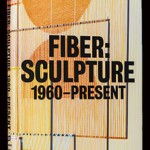 Fiber Sculpture: 1960-Present by Jenelle Porter. Mary Merkel-Hess says her favorite book on art this year was
Fiber Sculpture: 1960-Present by Jenelle Porter. Mary Merkel-Hess says her favorite book on art this year was Playing to the Gallery by Grayson Perry, a British ceramic artist, described by one reviewer as “a man in a frock who makes pots with rude designs.” Mary describes it as “a quirky, personal and lively journey through the issues facing the contemporary art world and a lot of it is hilarious – especially the illustrations.”
Heidrun Schimmel read, “with great pleasure,” The Blazing World by Siri Hustvedt (Simon and Shuster, New York 2014). “And not always with great pleasure,” Heidrun says she read,
All the World’s Futures: 56 International Art Exhibition, the catalogues for this year’s Venice Bienniale. “Most of the essays are very interesting and important,” she writes. “There were some very good pavilions in the Giardini this year, for example the Japanese Pavillon for the textile art scene.” Hisako Sekijima recommends a book in Japanese,
 U.S. Cultural Diplomacy and Japan in the Cold War Era (only the title is in English; the contents are in Japanese. It’s a 300-page hardcover book published by University of Tokyo Press, 2015) It is an extensive study done by Fumiko Fujita, ex-professor at Tsuda College. “Actually, the author is my college friend,” writes Hisako. Reading this book, she “happily” realized that she had been exposed to much of this cultural climate after the World War, as she grew up. “From home comedies, like Lassie to Edward Steichen’s The Family of Man, I learned — and was surprised — at the large extent to which numberless cultural programs had been politically planned to create a good partnership between US and Japan.” She was also surprised to learn such programs had been also worked to be less political or more culturally meaningful by the efforts done by enthusiastic and respectful private people like cultural attachés, artists or sports players. “I liked this latter part of the story! Though planned politically, such rich programs proved to influence us so much. I studied English and could enjoy my chance to live in NYC, where I came across with new waves in crafts.” Kay Sekimachi recommends Masters of Craft: Portraits by Paul Smith (and so do Tom and Rhonda) and also The Monocle Guide to Cozy Homes, edited by Tom Morris, Monocle (Gestalten, Berlin. 2015). Last Spring, Wendy Wahl began teaching, Soft Materials, a course in the department of Constructed Environments at Parson’s New School in New York. “In researching books for the course,” she writes, “I was reintroduced to Fabrics: A Guide for Interior Designers and Architects, by Mary Paul Yates (W.W.Norton). Imagine my delight to see the inclusion of Fiber Art and the images from browngrotta arts. At a rare and used bookstore I came upon
U.S. Cultural Diplomacy and Japan in the Cold War Era (only the title is in English; the contents are in Japanese. It’s a 300-page hardcover book published by University of Tokyo Press, 2015) It is an extensive study done by Fumiko Fujita, ex-professor at Tsuda College. “Actually, the author is my college friend,” writes Hisako. Reading this book, she “happily” realized that she had been exposed to much of this cultural climate after the World War, as she grew up. “From home comedies, like Lassie to Edward Steichen’s The Family of Man, I learned — and was surprised — at the large extent to which numberless cultural programs had been politically planned to create a good partnership between US and Japan.” She was also surprised to learn such programs had been also worked to be less political or more culturally meaningful by the efforts done by enthusiastic and respectful private people like cultural attachés, artists or sports players. “I liked this latter part of the story! Though planned politically, such rich programs proved to influence us so much. I studied English and could enjoy my chance to live in NYC, where I came across with new waves in crafts.” Kay Sekimachi recommends Masters of Craft: Portraits by Paul Smith (and so do Tom and Rhonda) and also The Monocle Guide to Cozy Homes, edited by Tom Morris, Monocle (Gestalten, Berlin. 2015). Last Spring, Wendy Wahl began teaching, Soft Materials, a course in the department of Constructed Environments at Parson’s New School in New York. “In researching books for the course,” she writes, “I was reintroduced to Fabrics: A Guide for Interior Designers and Architects, by Mary Paul Yates (W.W.Norton). Imagine my delight to see the inclusion of Fiber Art and the images from browngrotta arts. At a rare and used bookstore I came upon The Root of Wild Madder: Chasing the History, Mystery and Lore of the Persian Carpet by Brian Murphy (Simon and Schuster). The author takes the reader on a magic carpet ride traveling in the regions of its origins and destinations to tell the stories of the dyers, weavers and sellers of this remarkable art form. At my local public library I found

Randy Walker writes, “At the risk of appearing immodest, I’m recommending a book of poetry, The Genome Rhapsodies, that has one of my pieces on the cover. And I’m not even an avid poetry reader. When I was approached by Anna George Meek, a friend and accomplished poet, about using an image of my first public art installation, Woven Corncrib, on the cover of her new collection of poems, I was, of course, honored. But that’s not why I’m recommending this book. As we worked together to find an appropriate image, a series of conversations ensued over several months. These conversations were about histories, found objects, genetic material, fibers of all kinds woven throughout our lives. Gradually, I began to see clearly why Anna would venture to adorn her book, winner of the Richard Snyder Publication Prize and a product of over 15 years of work, with an image of an old steel corn crib woven with 300 pounds of salvaged fiber. Reading these poems, some deeply personal, opened an expansive view to me of a world that, as a primarily visual person, I don’t usually glimpse.” Tom and Rhonda recommend Organic Portraits, a photography book by John Cooper. Cooper’s organic portraits will be on exhibit this Spring at the Morris Museum in New Jersey in conjunction with Green from the Get Go: International Contemporary Basketmakers, from March 19 to June 26, 2015. “From the beginning,” Cooper explains, “the intent of the Organic Portraits project was to create a series of timeless and fundamentally beautiful images that would create awareness for—and help preserve—the world’s rainforests. In the 1950s, around the time I was born, about 15 percent of Earth’s landmass was covered with oxygen-generating and carbon-dioxide storing rainforests. At the time of this book’s publication, fewer than 70% of those forests remain. The aim of this project is to drive home the understanding that our rainforests— the lungs of our Earth— are both vital and in dire need of protection.” Cooper published Organic Portraits through a Kickstarter campaign; he is donating all profits from the book to the Rainforest Action Network Fund.
We hope your holidays provide you lots of leisure reading time!












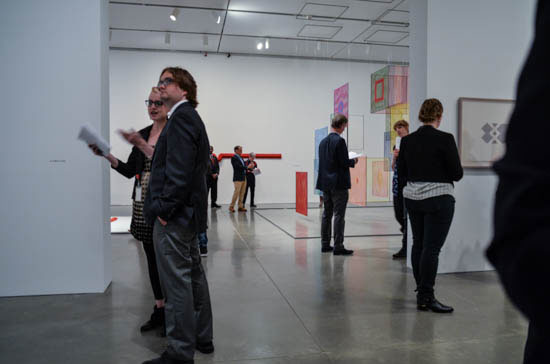

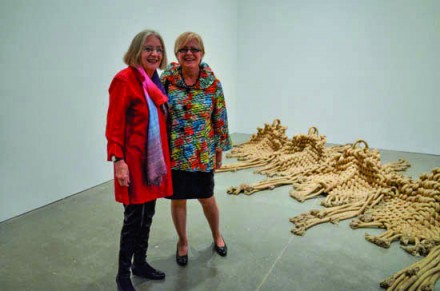
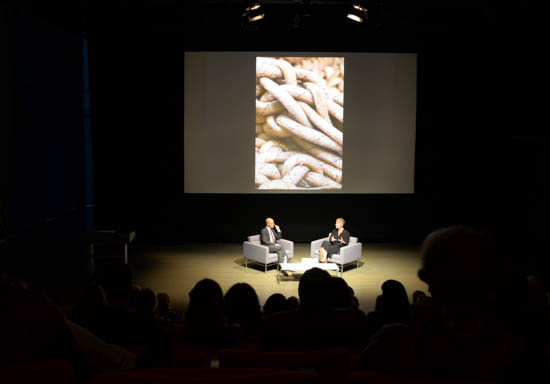

The Resurgence of Interest in Fiber Sculpture and Art Textiles Will Continue in 2015
Last year was an extraordinary one for those of us who appreciate contemporary art fiber and art textiles. More than 10 exhibitions opened in the US and abroad. In October, the art newspaper reported that “textiles are gaining international stature in art museums” and further that “[c]ommercial interest is on the rise,” quoting art advisor Emily Tsingou: “Textile [art] has entered the mainstream.” Soft Fabrics-Have Solid Appeal. Below is a roundup of exhibitions and reviews from last year and a guide to what to expect in 2015.
Mainstream attention began with the coverage of Sheila Hicks‘ inclusion
Sheila Hicks, Pillar of Inquiry/Supple Column, 2013-14 (installation view, Whitney Museum of American Art, New York). Photograph by Bill Orcutt
in the Whitney Biennial in March and was followed by coverage of the restoration of her remarkable 1960s tapestries at the Ford Foundation in New York Sheila Hicks Tapestries to Again Hang at Ford Foundation. In June, the Art Institute of Chicago’s textile galleries reopened, featuring 96-year-old Ethel Stein’s work, in Ethel Stein, Master Weaver.
September saw three fiber-related exhibitions; the Museum of Arts and Design opened What Would Mrs. Webb Do? A Founder’s Vision (closes
February 8, 2015),Kay Sekimachi, Ed Rossbach, Françoise Grossen, Katherine Westphal and others Museum of Art Design installation of What Would Mrs Webb Do?, Photo by Tom grotta
February 8, 2015), which featured significant textiles from the permanent collection by Anni Albers, Kay Sekimachi, Katherine Westphal, Ed Rossbach, Françoise Grossen and Trude Guermonprez, while The Drawing Center’s: Thread-Lines offered Anne Wilson creating fiber art in situ
Ann Wilson’s In Situ Performance at the Drawing Center, photo by Tom Grotta
together with a collection of works by Lenore Tawney, Louise Bourgeois and others. Contemporary 108 in Tulsa, Oklahoma, featured a series of large photographic weavings by Aleksandra Stoyanov of the Ukraine
Contemporary 108 in Tulsa, Oklahoma, curated from the 2013 “Aleksandra Stoyanov” Tefen Open Museum, Israel exhibition. photo copyright Tefen Open Museum
and now Israel, described as “warp and weft paintings.”
In October, Fiber: Sculpture 1960 – present, opened at the Institute of Contemporary Art in Boston with works by 34 artists including
Fiber: Sculpture 1960 — present opening, photo by Tom Grotta
Magdalena Abakanowicz, Ritzi Jacobi and Naomi Kobayashi. The Boston Globe called the exhibition “[s]plendid, viscerally engaging…groundbreaking;” the exhibition catalog (available at browngrotta.com) was pronounced by Blouin art info, “an amazing resource for anyone interested in learning more about the medium.” Art Info – Art in the Air Fiber Sculpture 1960 Present October also saw a survey of the work of sculptor and poet, Richard Tuttle, at the Tate in London, Richard Tuttle:
I Don’t Know, Or The Weave of Textile Language in which Tuttle investigated the importance of textiles throughout history, across his remarkable body of work and into the latest developments in his practice. Tate Modern – Richard Tuttle I Don’t Know or Weave Textile Language
Throughout the year, Innovators and Legends, with work by 50 fiber
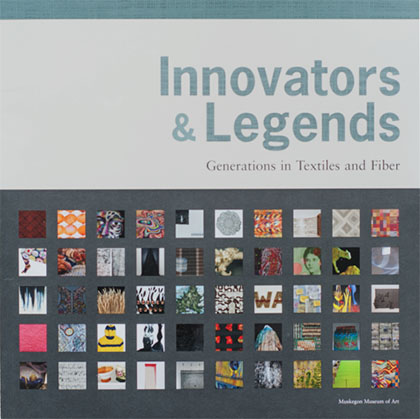
artists, including Adela Akers, Nick Cave, Katherine Westphal and Sherri Smith toured the US, exhibiting at museums in Colorado, Iowa and Kentucky. The fiber fanfest culminated at Art Basel in Miami Beach in December, where Blouin’s Art Info identified a full complement of fiber works and textiles in its listing, “Definitive Top 11 Booths, “ including Alexandra da Cunha’s compositions of mass-produced beach towels and various colored fabrics at Thomas Dane Gallery, a Rosemarie Trockel embroidered work at Galerie 1900-2000, marble and dyed-fabric pieces by Sam Moyer at Galerie Rodolphe Janssen and woven paintings by Brent Wadden at Mitchell-Innes & Nash Blouin Art info – The Definitive Top-11 Booths at Art Basel Miami Beach.
And what’s ahead in 2015?
More auctions and exhibitions that include fiber sculpture and art textiles are scheduled for 2015. Fiber: Sculpture 1960 – present will
open at the Wexner Center for the Arts, Columbus, Ohio on February 7th and travel to the Des Moines Art Center, Iowa in May.
Sonia Delaunay Prismes electriques 1914 Centre Pompidou Collection, Mnam / Cci, Paris © Pracusa 2013057
dedicated her life to experimenting with color and abstraction, bringing her ideas off the canvas and into the world through tapestry, textiles, mosaic and fashion.
Also in April, the Museum of Arts and Design will host Pathmakers:
Lenore Tawney in her Coenties Slip studio, New York, 1958.
Courtesy of Lenore G. Tawney Foundation; Photo by David Attie
Women in Art, Craft and Design, Midcentury and Today, featuring work by Sheila Hicks, Lenore Tawney and Dorothy Liebes http://madmuseum.org/exhibition/pathmakers.
In June, the Toms Pauli Foundation in Lausanne, Switzerland will celebrate the International Tapestry Biennials held there from 1962 to 1995 and display work by the Polish textile artist and sculptor Magdalena Abakanowicz, in an exhibition entitled, Objective Station.
1995 and display work by the Polish textile artist and sculptor Magdalena Abakanowicz, in an exhibition entitled, Objective Station.
Also this summer, the Musée d’Art Contemporain de Baie St Paul in
Mariette Rousseau Vermette Portrait by Tom Grotta
Quebec, Canada will examine the work of Mariette Rousseau-Vermette, who participated in five of the Lausanne Biennials.
From April 24 – May 3, 2015, browngrotta arts will host Influence and Evolution, Fiber Sculpture then and now at our barn/home/gallery space in Wilton, Connecticut. In its 27-year history, browngrotta arts
Françoise Grossen, From the Mermaid Series IV, 1983, photo by Tom Grotta
including Magdalena Abakanowicz, Lia Cook, Kay Sekimachi and Françoise Grossen, with works from a later generation of artists, all born after 1960, through whom fiber sculpture continues to evolve. These artists, including María Eugenia Dávila and Eduardo Portillo of Venezuela, Stéphanie Jacques of Belgium and Naoko Serino of Japan, work in a time when classification of medium and material presents less of a constraint and fiber and fiber techniques can be more readily explored for their expressive potential alone.
“It is rare to find so many inventive, compelling works in one show, and it astounds that many are so little known,” wrote Kirsten Swenson in Art in America, about Fiber: Sculpture 1960 – present, in October 2014. Art in America Magazine – reviews: Fiber Sculpture 1960-present. This spring, in Influence and Evolution, browngrotta arts will offer dozens more significant works of fiber art for collectors to appreciate and new audiences to discover — more than two dozen works by fiber pioneers and another 30 more recent fiber explorations. We hope you will visit the exhibition, order the catalog or both. Please contact us for more information about what’s in store. art@browngrotta.com